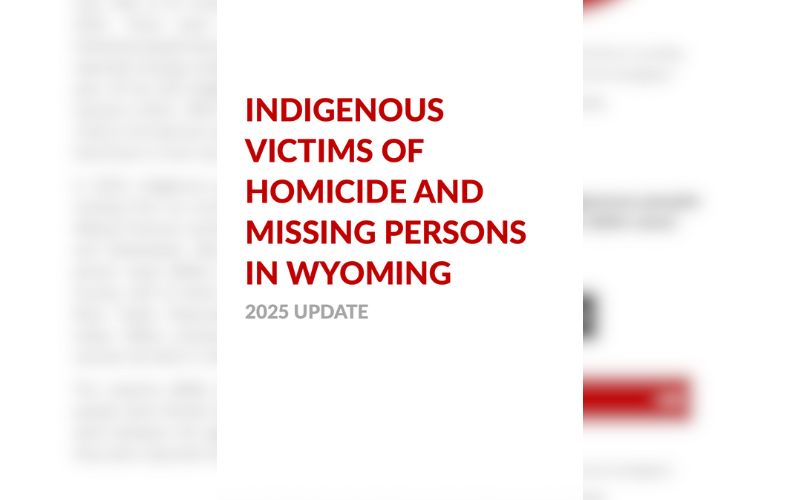
- Details
- By Elyse Wild
Poor communication between law enforcement agencies continues to hamper efforts to address Wyoming’s Missing and Murdered Indigenous Peoples (MMIP) crisis, according to a report released last week that found substantial data discrepancies between federal databases.
The report found that Indigenous people, on average, are missing for twice as long as white people.
The Indigenous Victims of Homicide and Missing Persons in Wyoming 2025 Update reveals that Native Americans represented nearly 20% of Wyoming’s missing persons cases last year, despite being just 3% of the state’s population — a figure largely unchanged from 2023. About 85% of reported cases originated from Fremont County, with half from the Wind River Reservation, home of the Northern Arapaho and Eastern Shoshone tribes. The majority of those reported missing were young women between the ages of 5 and 17.
Nicole Wagon (Northern Arapaho), an advocate who lost two daughters to the Missing and Murdered Indigenous People (MMIP) crisis, told Native News Online.
The report shows that 151 missing person records were added to the National Crime Information Center (NCIC) in 2024 for the state of Wyoming; The Bureau of Indian Affairs (BIA) — which is only responsible for cases occurring on reservation land —recorded 65 of the cases in its database.
“Indigenous people, we just don’t go missing on a reservation,” Wagon said. “We go missing everywhere.”
Shay Jimerson (Eastern Shoshone), a board member of the Wyoming MMIP advocacy group MMIR 307, said the contrast in the BIA and NCIC case numbers underscores the importance of local and state-level action.
“Wyoming’s 151 entries for Indigenous individuals show a more active approach to tracking missing persons, especially compared to the Bureau of Indian Affairs’ numbers for all of Indian Country,” Jimerson said. “It suggests that when states and local jurisdictions take ownership and commit to robust reporting, better data—and potentially better outcomes—can follow. It also highlights how critical consistent standards and mandatory reporting laws are to ensure Indigenous people don’t fall through jurisdictional gaps.”
The report points to the state’s progress in implementing recommendations made by the Wyoming MMIP Taskforce, including creating clear and consistent protocols and data systems for quicker action when a person is reported missing.
Earlier this year, Wyoming formally adopted a measure requiring law enforcement to add missing persons to state and national databases as soon as they are reported missing. It also mandates that officers file a missing persons report within eight hours of being notified. The law goes into effect on July 1, 2025.
As of February 2025, according to the report, two adult males, one juvenile male and three juvenile females, all Indigenous, are actively missing in Wyoming; however, there are only two listed in the NamUS database.
Jimerson said she would like to see more expanded data from tribal, state, and federal sources integrated more comprehensively into the NamUs.
“[That database] remains underutilized. Greater community engagement, more qualitative insights from families, and a deeper look at long-term trends would also help move this work forward in a way that’s both data-driven and human-centered,” she said.
Native people are murdered at a rate 10 times the national average. Homicide is one of the leading causes of death for Native women ages 10-34. The Bureau of Indian Affairs estimates there are 4,200 unsolved MMIP cases, although those numbers are outdated and the actual number is likely higher, Native advocates say.
The Not Invisible Act Commission —a federal commission tasked with developing federal recommendations to solve the nation’s MMIP crisis — released its final report to Congress last November. The report identified inconsistent, inaccurate, and disparate data as a driving force for high rates of unsolved missing persons and murder cases in Native communities.
The report notes that there are more than 18,000 federal, state, county, tribal, and local law enforcement agencies in the U.S., all of which have their standard operating procedures and guidelines for data collection and entry in their agency’s case management systems as well as others they may use to help solve cases. Earlier this year, the report was removed from the Department of Justice website.
More Stories Like This
HHS Repeals Nursing Home Staffing Requirements, Citing Relief for Tribal FacilitiesNative Americans Face Second-Highest Gun Death Rate in U.S., New Study Shows
National Council of Urban Indian Health Encourages Vaccinations
New Native Nations Center for Tribal Policy Research Analyst Will Examine Cancer Disparities in Oklahoma Tribes
Republicans Left Tribes Out of Their $50B Rural Fund. Now It’s Up to States To Share.

